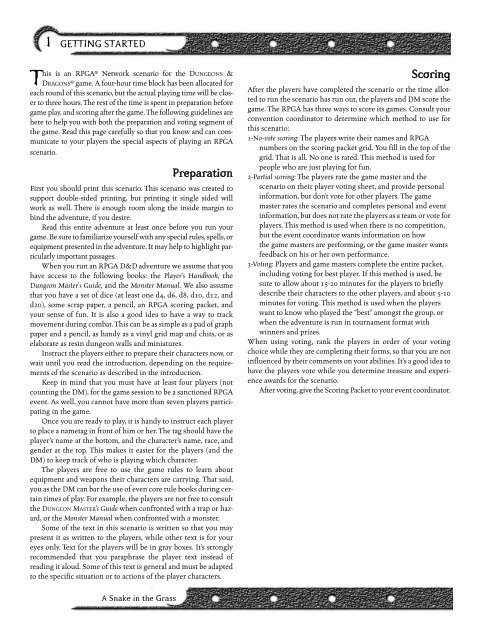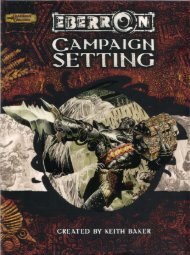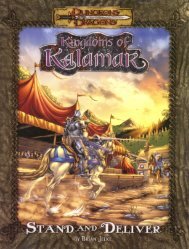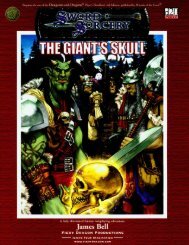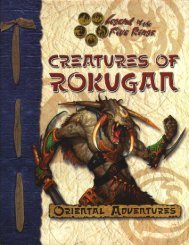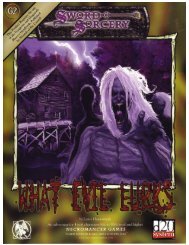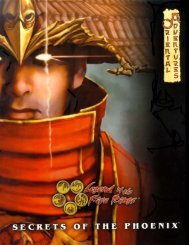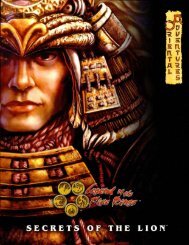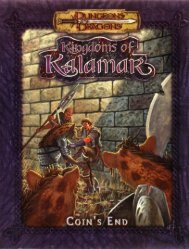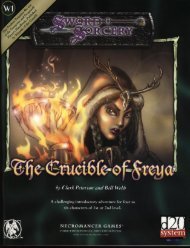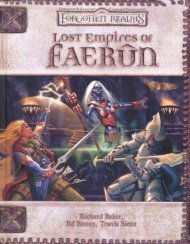RPGA Living Greyhawk - Snake In The Grass.pdf
RPGA Living Greyhawk - Snake In The Grass.pdf
RPGA Living Greyhawk - Snake In The Grass.pdf
You also want an ePaper? Increase the reach of your titles
YUMPU automatically turns print PDFs into web optimized ePapers that Google loves.
1<br />
GETTING STARTED<br />
This is an <strong>RPGA</strong>® Network scenario for the DUNGEONS &<br />
DRAGONS® game. A four-hour time block has been allocated for<br />
each round of this scenario, but the actual playing time will be closer<br />
to three hours. <strong>The</strong> rest of the time is spent in preparation before<br />
game play, and scoring after the game. <strong>The</strong> following guidelines are<br />
here to help you with both the preparation and voting segment of<br />
the game. Read this page carefully so that you know and can communicate<br />
to your players the special aspects of playing an <strong>RPGA</strong><br />
scenario.<br />
A <strong>Snake</strong> in the <strong>Grass</strong><br />
Preparation<br />
First you should print this scenario. This scenario was created to<br />
support double-sided printing, but printing it single sided will<br />
work as well. <strong>The</strong>re is enough room along the inside margin to<br />
bind the adventure, if you desire.<br />
Read this entire adventure at least once before you run your<br />
game. Be sure to familiarize yourself with any special rules, spells, or<br />
equipment presented in the adventure. It may help to highlight particularly<br />
important passages.<br />
When you run an <strong>RPGA</strong> D&D adventure we assume that you<br />
have access to the following books: the Player’s Handbook, the<br />
Dungeon Master’s Guide, and the Monster Manual. We also assume<br />
that you have a set of dice (at least one d4, d6, d8, d10, d12, and<br />
d20), some scrap paper, a pencil, an <strong>RPGA</strong> scoring packet, and<br />
your sense of fun. It is also a good idea to have a way to track<br />
movement during combat. This can be as simple as a pad of graph<br />
paper and a pencil, as handy as a vinyl grid map and chits, or as<br />
elaborate as resin dungeon walls and miniatures.<br />
<strong>In</strong>struct the players either to prepare their characters now, or<br />
wait until you read the introduction, depending on the requirements<br />
of the scenario as described in the introduction.<br />
Keep in mind that you must have at least four players (not<br />
counting the DM), for the game session to be a sanctioned <strong>RPGA</strong><br />
event. As well, you cannot have more than seven players participating<br />
in the game.<br />
Once you are ready to play, it is handy to instruct each player<br />
to place a nametag in front of him or her. <strong>The</strong> tag should have the<br />
player’s name at the bottom, and the character’s name, race, and<br />
gender at the top. This makes it easier for the players (and the<br />
DM) to keep track of who is playing which character.<br />
<strong>The</strong> players are free to use the game rules to learn about<br />
equipment and weapons their characters are carrying. That said,<br />
you as the DM can bar the use of even core rule books during certain<br />
times of play. For example, the players are not free to consult<br />
the DUNGEON MASTER’s Guide when confronted with a trap or hazard,<br />
or the Monster Manual when confronted with a monster.<br />
Some of the text in this scenario is written so that you may<br />
present it as written to the players, while other text is for your<br />
eyes only. Text for the players will be in gray boxes. It’s strongly<br />
recommended that you paraphrase the player text instead of<br />
reading it aloud. Some of this text is general and must be adapted<br />
to the specific situation or to actions of the player characters.<br />
Scoring<br />
After the players have completed the scenario or the time allotted<br />
to run the scenario has run out, the players and DM score the<br />
game. <strong>The</strong> <strong>RPGA</strong> has three ways to score its games. Consult your<br />
convention coordinator to determine which method to use for<br />
this scenario:<br />
1-No-vote scoring: <strong>The</strong> players write their names and <strong>RPGA</strong><br />
numbers on the scoring packet grid. You fill in the top of the<br />
grid. That is all. No one is rated. This method is used for<br />
people who are just playing for fun.<br />
2-Partial scoring: <strong>The</strong> players rate the game master and the<br />
scenario on their player voting sheet, and provide personal<br />
information, but don’t vote for other players. <strong>The</strong> game<br />
master rates the scenario and completes personal and event<br />
information, but does not rate the players as a team or vote for<br />
players. This method is used when there is no competition,<br />
but the event coordinator wants information on how<br />
the game masters are performing, or the game master wants<br />
feedback on his or her own performance.<br />
3-Voting: Players and game masters complete the entire packet,<br />
including voting for best player. If this method is used, be<br />
sure to allow about 15-20 minutes for the players to briefly<br />
describe their characters to the other players, and about 5-10<br />
minutes for voting. This method is used when the players<br />
want to know who played the “best” amongst the group, or<br />
when the adventure is run in tournament format with<br />
winners and prizes.<br />
When using voting, rank the players in order of your voting<br />
choice while they are completing their forms, so that you are not<br />
influenced by their comments on your abilities. It’s a good idea to<br />
have the players vote while you determine treasure and experience<br />
awards for the scenario.<br />
After voting, give the Scoring Packet to your event coordinator.


